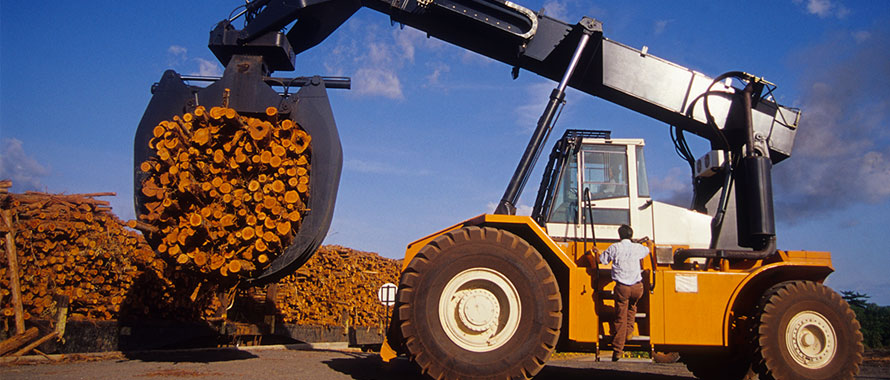According to National Resources Canada, the forestry industry directly employs 216,500 people, contributing $19.8 billion to Canada’s gross domestic product (GDP).
An industry with such significant economic impact is at risk when underinsured loggers are managing projects. After all, every day logging machinery is silent is a day of lost revenue. With proper insurance, logging camps can get back to work quickly after an interruption.
The Oldest Risk Remains
When asked to identify the risks loggers and contractors face, Steve McQueen, Managing Director, Atlantic Region for Burns & Wilcox Canada, explains, “Fire is still the main cause of claims and the main risk in a logging camp. Forest fire, overheating, and lack of proper maintenance of the under-pan are the most frequent causes of fire losses. Even with top notch care of the machines, there can be an oil leak that causes a fire.”
Fire Details to Consider
According to McQueen, “With a fire, the loss is usually a total loss and the resulting downtime is extremely expensive. The contractor risks losing the contract if they are unable to fulfill the requirements in time.” When equipment is down, loggers must rent machinery to continue working. Rental reimbursement can be an attractive component of insurance coverage, but advanced research is required to ensure it is worth the cost. Policies do not guarantee access to rental equipment, but cover the rental cost of equipment rented after an insured loss. In order to make the most of a policy, brokers should identify comparable equipment that can be leased in the insured’s area. If the equipment is not readily available to rent from a nearby dealer, the risk of downtime increases. McQueen advises brokers to take time to research the availability of comparable equipment. When it is not realistic to offer rental reimbursement, then offer a business interruption supplement to the policy.
Work in logging camps can be ongoing with back-to-back day and night shifts and with machines only stopping once a week for an 8-12 hour maintenance shift. The maintenance shift can make all the difference for fire prevention. It is when the machinery is checked for oil leaks and other problems that can cause a fire. To write the most appropriate coverage, underwriters require full details about the logging company’s maintenance schedule along with serial numbers, makes and models of all machinery to be covered by the policy. Brokers and agents should prepare clients for maintaining a complete record of machinery inventory.
Mauricio Zani, Senior Inland Marine Underwriter, Burns & Wilcox Canada, also cautioned that, “Brokers should ensure the valuation on each piece of machinery is appropriate and consider currency fluctuations as well if the machinery was purchased in the U.S. and is being used in Canada. The relative strength of the Canadian dollar can change the value of machinery by as much as 30 percent.” Zani stresses that not all logging operations are equal. Some loggers have brand new $1 million harvesters and others have $100,000 skidding machines; the value and class of the machinery impacts the policy with respect to rating, deductible, valuation and final premium.
Fire-fighting expenses are now a logger’s liability, which means that logging contractors are held liable by law or statute for some of the cost of firefighting. “If an insured’s machinery is caught in a forest fire and the local fire department responds in an attempt to save the machinery and timber within their cutting rights, the logger will be required to pay part of the expenses of fighting the fire for which they become legally liable,” explained Zani. The loggers are a beneficiary of the firefighting which is more expensive for the local municipality than letting a forest fire run its natural course.
Additional Tips for Serving Logging Clients
“While a handshake used to be enough to seal a deal in the timber industry, drivers hauling for the logging industry now need to carry $5 million liability coverage as companies are paying close attention to new requirements,” said Zani. This shift in the industry from handshakes to formal contracts has accompanied a shift in coverage for those who contract at all levels in logging from drivers to major contractors.
Accidents can happen on the most professionally run work sites, and not every person on the job site may be eligible for worker’s comp. Accidental Death and Dismemberment coverage is available to fill the gap and provide financial support to a worker and their family if an accident occurs that leaves the logger unable to work. The accidental death and dismemberment coverage should be included in the logging contractor’s annual policy to protect their workers. McQueen also suggests that brokers talk to their clients about Sudden and Accidental Pollution coverage in case of an environmental accident, such as a hydraulic hose breakage that pollutes a nearby water source. Sudden and Accidental Pollution will help the logging contractor remediate the environmental damage and protect the forest jobsite.
Brokers and agents have the tools at their disposal to guide their clients and ensure they have protections necessary for the risks loggers face. Whether the age-old risk of fire, a first-time policy for a decades-old business or environmental protections, together with insurance experts, the logging industry can strive to be safer and more productive.


